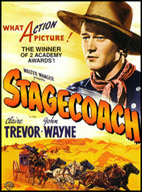Film Score: Richard Hageman Cinematography: Bert Glennon
Starring: John Wayne, Claire Trevor, Thomas Mitchell and John Carradine
Throughout the thirties, John Wayne had made dozens of low-budget westerns for poverty row companies like Republic and programmers for small studios like Universal. But appearing in Stagecoach, for John Ford, was his big break and he never looked back. It was a great part for him, too. Ostensibly a criminal as the film opens, he is actually the moral center of the piece. But the film contains a host of great stars and is really an ensemble piece. The story is based on an Ernest Haycox short story called “The Stage to Lordsberg” and was the first of so many Ford westerns that would be filmed in Monument Valley on the Arizona Utah border. In fact, it was Ford’s first western during the sound period and launched his career as a specialist in that genre as well. His belief in the material was rewarded when the film was a huge hit in a year that saw so many other great Hollywood films.
The film begins with a military fort being told to look out for Apache war raids. From there the scene shifts to a small western town in Arizona as the stagecoach arrives. Andy Devine is the driver and is told by the sheriff that John Wayne, as the Ringo Kid, has escaped prison. Meanwhile prostitute Claire Trevor is being run out of town by the ladies of the Law and Order League and drunken doctor Thomas Mitchell has been kicked out of his rooming house for not paying his rent. They all board the coach with whiskey salesman Donald Meek, gambler John Carradine, a woman going to see her soldier husband, and the banker who’s running away from his wife. The group heads into Indian country with no cavalry escort and picks up Wayne along the way. Some of the passengers are running away, and some are heading to Lordsberg for very specific reasons, Wayne in particular to avenge the deaths of his father and brother.
The first shot of John Wayne is tremendous, a beautiful tracking shot pushing in on his youthful face. It was a great way of introducing him to the world of high quality feature films, though it almost didn’t happen. Ford hadn’t directed a western since the silent era and the studios felt that big-budget westerns were out. He had taken the film to David O. Selznick but the mogul didn’t have enough control over Ford and eventually dropped the project. Ford finally found financing from Walter Wanger, but the producer wanted to replace Ford’s stars with Gary Cooper and Marlene Dietrich. Ford flatly refused and still wound up getting half the money he needed and went ahead with filming. Even in an artistically rich year for feature films, Stagecoach garnered seven Academy Award nominations with wins for the distinctive score and for Thomas Mitchell’s wonderful supporting performance.
The two stars, Claire Trevor and John Wayne are the focal point of the piece. But while the audience knows that Trevor is a prostitute there is the possibility that Wayne, who has been in prison for several years, doesn’t have a clue. After Louise Platt’s baby is born and Trevor is holding the child, Wayne’s expression is positively breathless with desire. It’s a beautiful scene. But what makes Wayne’s part so great is the idea that, even though Trevor is afraid to tell him what she really is and doesn’t answer his proposal because of it . . . he already knows. This makes all of the references to her as a lady earlier in the film take on so much more meaning and deepens the moral center that Wayne’s character provides. Of course it can be interpreted the other way, where he simply doesn’t care at the end, but I think it makes a much more powerful film if he does. Stagecoach, the first major western for John Ford and John Wayne is simply a classic.

No comments:
Post a Comment